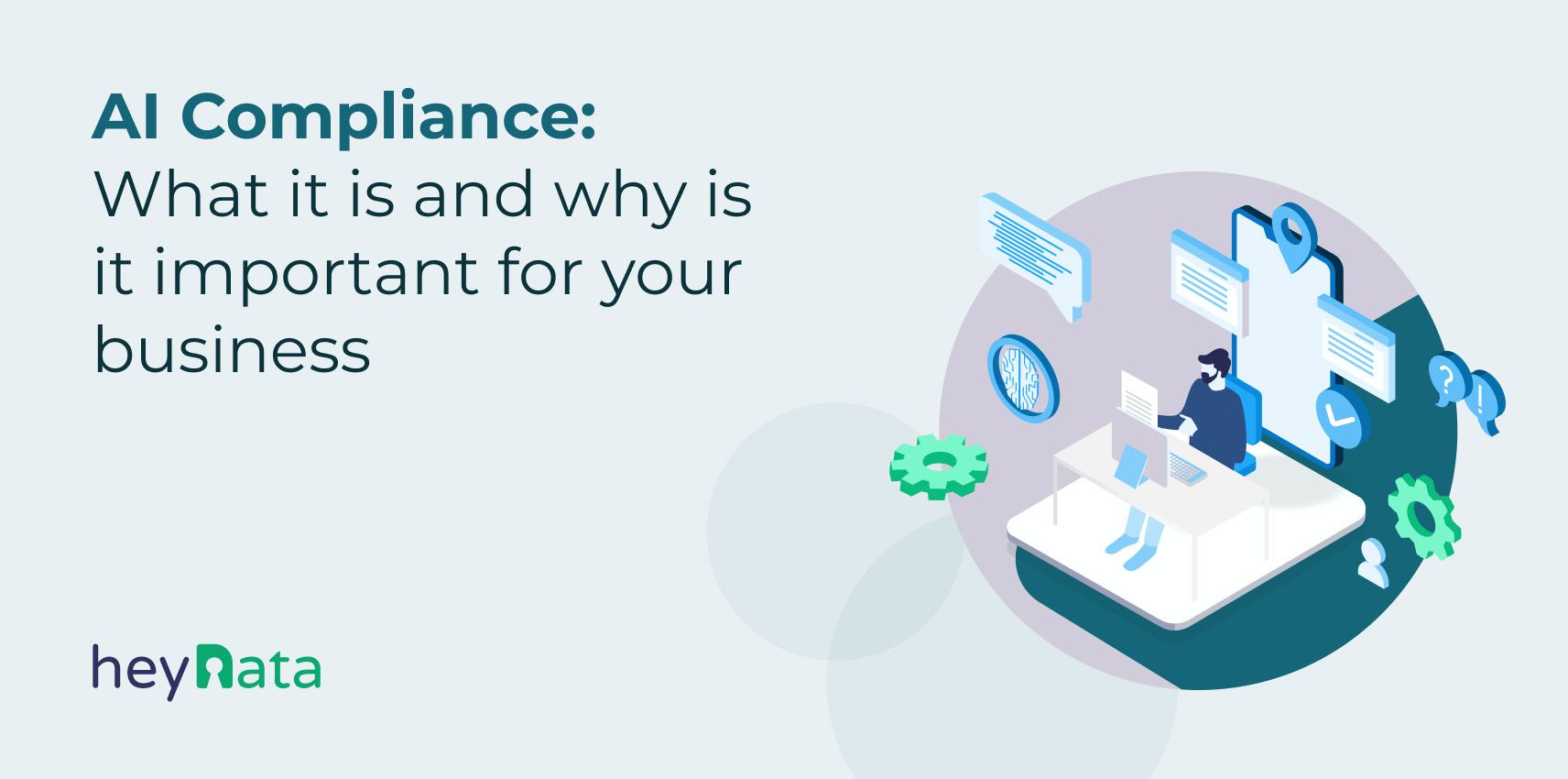
What is AI Compliance and Why It Matters to Your Business

Artificial intelligence (AI) has emerged as a transformative force across various industries in today's fast-growing technological landscape. From automating repetitive tasks to optimizing decision-making processes, AI offers unprecedented opportunities for businesses to enhance efficiency, productivity, and innovation. However, with great power comes great responsibility. Ensuring AI compliance has become paramount for organizations worldwide.
Let's dive into what AI compliance truly is, why it's crucial, legal and regulatory requirements such as the EU AI Act, examples of non-compliance, and practical steps to ensure adherence to AI standards.
Related topic: Safeguarding Data Protection and Compliance when utilizing AI
Table of Contents:
Understanding AI Compliance
AI compliance ensures that AI-powered systems adhere to all applicable laws, regulations, and ethical standards. It serves as a foundational framework guiding businesses to navigate the intricate web of legal, regulatory, and ethical considerations inherent in AI deployment.
1. Legal and Ethical Usage
This involves ensuring that AI systems are used within the bounds of applicable laws, regulations, and ethical guidelines. This includes understanding and adhering to regulations, such as the GDPR (General Data Protection Regulation), HIPAA (Health Insurance Portability and Accountability Act), and various industry-specific regulations. Ethical considerations involve evaluating the potential impact of AI systems on individuals, communities, and society as a whole, and ensuring that their deployment aligns with ethical principles such as fairness, transparency, accountability, and inclusivity.
2. Data Privacy and Security
AI systems often rely on large volumes of data to function effectively, whether for training, testing, or deployment. Compliance in this area involves ensuring that data used to train AI models is collected and processed following relevant privacy laws and regulations, such as the GDPR and others. It also involves implementing strong security measures to protect this data from unauthorized access, breaches, or misuse. This includes encryption, access controls, data anonymization techniques, and regular security audits.
3. Reinforcing Responsibility and Accountability
AI systems can have significant impacts on individuals, organizations, and society at large. Ensuring responsible and accountable use of AI involves considering the broader societal implications of AI deployment and taking steps to mitigate potential risks. This includes implementing mechanisms for transparency and explainability in AI systems so that their decision-making processes are understandable and auditable. It also involves establishing clear lines of responsibility and accountability for the design, development, deployment, and monitoring of AI systems, both within organizations and at a broader societal level.
Importance of AI Compliance
AI compliance is essential for numerous reasons. When organizations adhere to AI compliance standards, they place a premium on safeguarding individuals' rights, reducing legal and financial risks, and upholding ethical principles.
At the core of compliance lies the assurance of privacy and security, attained through conscientious data management practices, thereby shielding sensitive information from misuse or unauthorized access. Moreover, compliance initiatives play a strong role in cultivating trust and preserving a favorable reputation.
By aligning with ethical standards, businesses can enhance transparency and credibility in the deployment and utilization of AI technologies, consequently reinforcing stakeholder confidence in the organization's integrity and dependability.
The New EU AI Act
The EU AI Act, proposed by the European Commission, stands as pioneering legislation aiming to regulate AI technologies comprehensively. Key objectives include:
- Protecting Fundamental Rights: Emphasizing fairness, non-discrimination, privacy, and safety.
- Balancing Innovation and Protection: Categorizing AI systems based on risk levels to foster innovation while safeguarding individuals.
- Setting Global Standards: Positioning the EU as a leader in ethical AI governance, encouraging global adoption of similar standards.
The AI Act aims to regulate artificial intelligence and set boundaries for its development and use in the European Union. Therefore, understanding these impacts is essential for businesses, especially SMEs to navigate the evolving landscape of AI development and use.
Examples of AI misuse
AI's potential for misuse has been underscored by various instances, shedding light on the risks associated with irresponsible technological deployment:
- AI Bias in Criminal Risk and Parole Decisions: ProPublica's investigation, along with other research, highlights significant bias in AI-driven algorithms used across the U.S. criminal justice system. These AI systems, employed to predict future criminal behavior and make parole decisions, systematically discriminate against People of Color (PoC), often due to biases in their training data. This misuse of AI not only deepens racial disparities in incarceration rates but also underscores the urgent need for comprehensive reforms to ensure fairness and transparency in AI applications within judicial processes.
- Flawed AI Recruitment Tools: Amazon's 2018 encounter with an AI-driven hiring tool brought to light the issue of gender bias in recruitment. The tool, programmed to favor male candidates, mirrored the gender gap prevalent in the tech industry. Amazon's subsequent retraction of the tool underscored the need to address discriminatory biases embedded within AI systems.
- Deepfakes and Security Risks: The emergence of deepfake technology, capable of generating synthetic media by seamlessly blending one person's likeness with another's in images or videos, presents a powerful threat to national security. Dr. Tim Stevens of King's College London warns that autocratic regimes could weaponize deepfakes to erode public trust in institutions, potentially destabilizing democratic societies. This underscores the urgent need for strong security against the misuse of synthetic media technologies.
- AI-Powered Photo Editing and Data Privacy: Privacy issues have plagued AI-driven applications, particularly those employing AI for enhancing photos. Concerns were raised regarding the privacy policy of FaceApp, which seemed to suggest a claim of ownership over user-uploaded photos, fueling discussions about the rights of data ownership and usage.
Consequences of non-compliance in AI
Non-compliance in AI can have significant implications, ranging from financial penalties to ethical concerns. Looking at real-world instances of AI non-compliance is essential in understanding the necessity of maintaining rigorous compliance standards.
- Facebook and Data Privacy: In 2019, Facebook was fined a record $5 billion by the Federal Trade Commission for privacy violations. The company’s use of AI in ad targeting involved analyzing user data without obtaining explicit user consent, a direct violation of data privacy regulations.
- Google and Misuse of AI: Google’s subsidiary, DeepMind, was involved in a controversy where it was accused of breaching the UK’s data protection laws. The company had shared the health data of 1.6 million patients with the Royal Free NHS Foundation Trust without explicit consent for testing its AI app.
Each of these examples underscores the importance of stringent AI compliance measures. They serve as reminders that even the most advanced tech giants are not immune to the risks associated with AI non-compliance.
AI Compliance Best Practices
By implementing robust compliance measures, businesses can navigate the complex landscape of AI development and deployment while upholding ethical principles and meeting regulatory requirements.
- Establish Clear Guidelines and Rules: Develop clear and comprehensive guidelines for the design, development, deployment, and use of AI systems within your organization. These guidelines should cover aspects such as data collection, model training, decision-making processes, and ethical considerations.
- Implement a Comprehensive Compliance Program: Establish a robust compliance program that encompasses all relevant laws, regulations, and industry standards on AI. This program should include regular assessments to ensure ongoing compliance and should be adaptable to changes in regulatory requirements.
- Regularly Assess AI Systems: Implement mechanisms for ongoing monitoring and evaluation of AI systems to ensure they adhere to legal and regulatory standards. This may involve conducting regular audits, assessments, and performance reviews to identify and address any compliance issues promptly.
- Design Tailored Governance: Develop a structure specifically tailored to oversee AI operations within your organization. This structure should define roles and responsibilities, establish reporting mechanisms, and ensure accountability at all levels of the organization.
- Prioritize Data Privacy and Security: Place a strong emphasis on protecting the privacy and security of data used by AI systems. Implement robust data protection measures, such as encryption, access controls, and data anonymization, to mitigate the risk of unauthorized access or data breaches.
- Setting up a regular auditing system: Establish a systematic approach to auditing AI operations to assess compliance with internal policies and external regulations. This may involve conducting internal audits, engaging third-party auditors, or leveraging automated tools for continuous monitoring and evaluation.
- Establish Procedures for Compliance Concerns: Develop a structured process for identifying, reporting, and addressing compliance concerns related to AI. This should include mechanisms for whistleblowing, escalation of issues, and remediation of non-compliance findings on time.
- Manage Risks Associated with AI: Proactively identify and manage risks associated with the use of AI within your organization. This may involve conducting risk assessments, implementing risk mitigation strategies, and establishing contingency plans to address potential adverse impacts of AI systems.
- Provide Staff Education on Compliance: Provide comprehensive training and awareness programs to educate staff about the compliance requirements related to AI. This should include training on relevant laws and regulations, ethical considerations, and best practices for ensuring compliance in AI operations.
Related topic: Compliant in just a few steps! Your External Data Protection Officer (DPO)
Final Notes
By prioritizing adherence to AI compliance standards, organizations demonstrate their commitment to protecting individuals' rights, mitigating legal and financial risks, and upholding ethical principles.
Become an expert in AI compliance today using the right tools. With heyData, you can navigate AI adoption confidently. We offer the essential tools and expert guidance necessary for ensuring your organization's AI systems adhere to relevant regulations and standards backed by cutting-edge technology and expert legal support.
Stay informed and join the waiting list for announcements regarding the official release of the heyData AI Solution AI Comply to ensure your AI systems comply with relevant regulations and standards.


